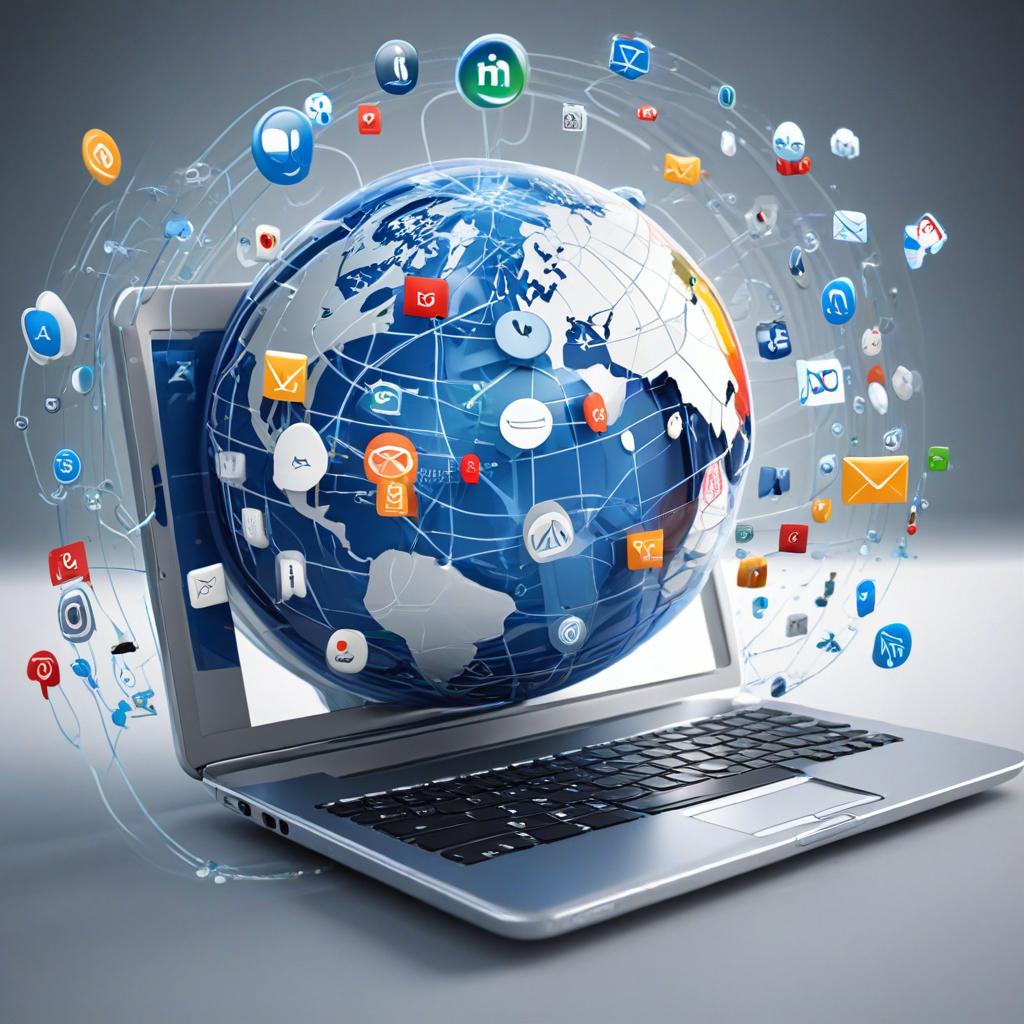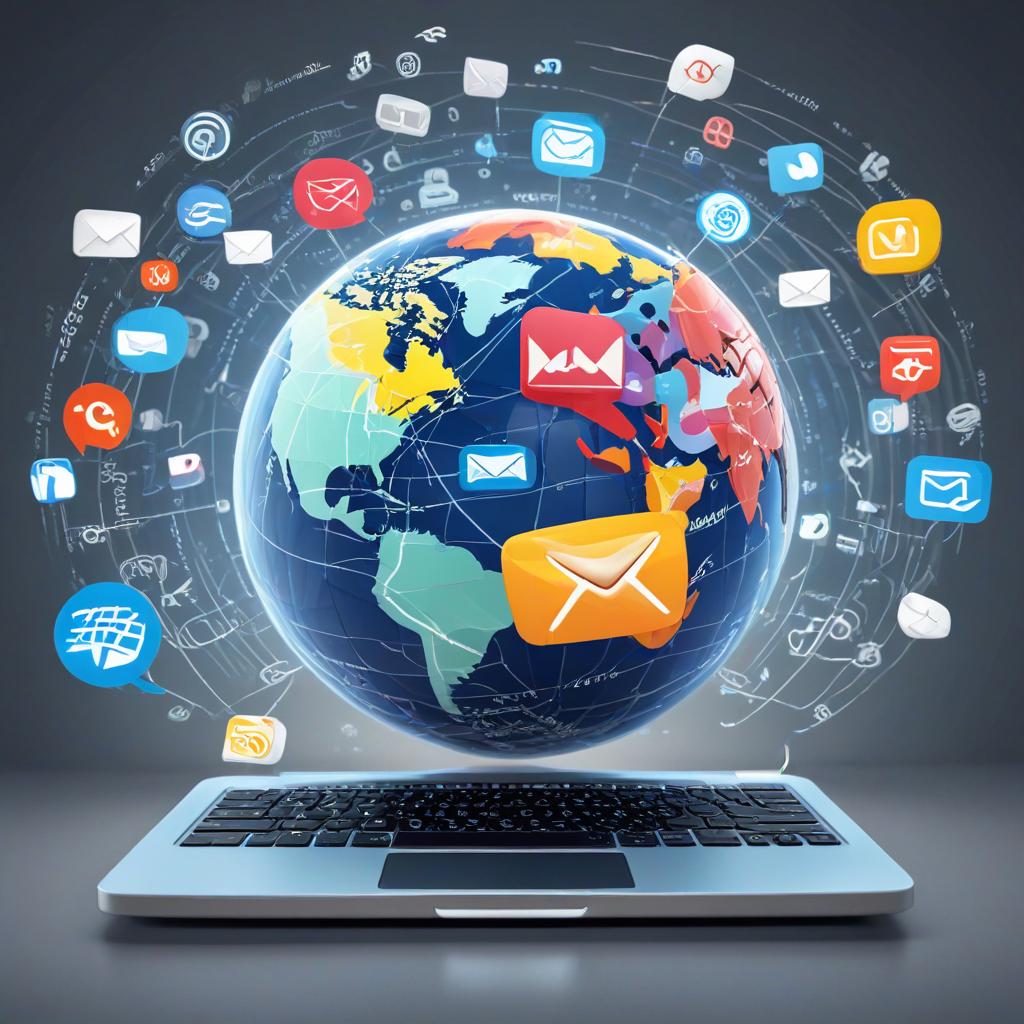Bridging the Language Gap in Internet and Email Communication: A Multilingual Future
Introduction
The internet and email have revolutionized global communication, but they predominantly operate in English, creating a barrier for non-English speakers. To harness the full potential of digitization and ensure inclusivity, it’s crucial to develop infrastructure that supports  interaction. This blog post delves into the current infrastructure, the technologies behind it, and the future requirements to enable seamless multilingual communication.
interaction. This blog post delves into the current infrastructure, the technologies behind it, and the future requirements to enable seamless multilingual communication.
The ability to communicate effectively across languages on the internet and through email is crucial for fostering global inclusivity and maximizing the benefits of digital communication. While English dominates these mediums, many users around the world are left out due to language barriers. This blog post explores how to create an infrastructure that supports multilingual communication, the current technologies in place, and the future advancements needed to achieve this goal.
Email Composition
- User Interface: The sender composes an email using an email client (e.g., Gmail, Outlook).
- Content: The email includes a recipient address, subject line, body text, and possibly attachments.
2. Email Submission
- SMTP Protocol: Simple Mail Transfer Protocol (SMTP) is used to send the email from the sender’s client to their outgoing mail server.
- Mail Server: The email client connects to the sender’s mail server using SMTP, typically on port 25, 587, or 465 (for SSL).
3. Email Routing
- DNS Lookup: The sender’s mail server performs a DNS (Domain Name System) lookup to find the recipient’s mail server. It queries the DNS for the MX (Mail Exchange) records of the recipient’s domain.
- Recipient Mail Server: Once the MX records are obtained, the sender’s server establishes a connection with the recipient’s mail server using SMTP.
4. Email Transfer
- Handshake and Transfer: The sender’s mail server and the recipient’s mail server perform an SMTP handshake to establish a connection. The email is then transferred to the recipient’s server.
- Queueing: If the recipient’s mail server is busy or unavailable, the sender’s server will queue the email and retry sending at intervals.
5. Email Reception
- Incoming Mail Server: The recipient’s mail server receives the email and stores it. This server typically uses protocols like IMAP (Internet Message Access Protocol) or POP3 (Post Office Protocol) to manage the received emails.
Recipient’s Mail Server
- Definition: The mail server is a computer system that manages and stores emails for users within a domain. It handles incoming and outgoing email traffic, ensuring that emails are properly routed and delivered.
- Function: When an email is sent to a recipient, it is first delivered to the recipient’s mail server. This server is responsible for receiving, storing, and making the email available for retrieval by the recipient’s mail client.
- Examples: Common mail server software includes Microsoft Exchange, Postfix, Exim, and cloud-based services like Gmail’s servers, Yahoo Mail servers, etc.
- Protocols Used:
- SMTP (Simple Mail Transfer Protocol): Used to receive emails from the sender’s server.
- IMAP (Internet Message Access Protocol) or POP3 (Post Office Protocol): Used to allow the mail client to retrieve emails.
Recipient’s Mail Client
- Definition: The mail client is a software application used by the recipient to access and manage their email. It provides a user interface for reading, composing, and organizing emails.
- Function: The mail client connects to the recipient’s mail server to fetch emails. It displays these emails to the user and allows them to interact with their messages. The mail client can also be used to compose and send new emails.
- Examples: Common mail clients include Microsoft Outlook, Mozilla Thunderbird, Apple Mail, Gmail app, and various other email apps and webmail interfaces.
- Protocols Used:
- IMAP: Allows the mail client to access and manage emails directly on the mail server, providing synchronization across multiple devices.
- POP3: Downloads emails from the server to the local device and typically deletes them from the server.
Interaction Between Mail Server and Mail Client
- Email Reception:
- When an email is sent to a recipient, it first arrives at the recipient’s mail server.
- The mail server stores the email and waits for the recipient’s mail client to retrieve it.
- Email Retrieval:
- The recipient’s mail client periodically connects to the mail server to check for new emails.
- Using IMAP or POP3 protocols, the mail client fetches the emails from the server.
- With IMAP, the emails remain on the server, allowing access from multiple devices. With POP3, the emails are downloaded to the local device and typically removed from the server.
- Email Management:
- The mail client allows the user to read, organize, and delete emails. Actions taken on the mail client (like reading or deleting an email) are communicated back to the mail server if using IMAP, ensuring synchronization.
- Email Sending:
- When the recipient sends a new email, the mail client connects to an SMTP server (often the same server handling incoming emails) to send the message.
- The SMTP server processes and routes the outgoing email to the recipient’s mail server.
Example Scenario
- Bob (Recipient) using Gmail:
- Mail Server: Bob’s email is hosted on Google’s mail servers (Gmail).
- Mail Client: Bob uses the Gmail app on his smartphone to access his email.
- Interaction:
- An email sent to bob@gmail.com is received by Google’s mail servers.
- Bob’s Gmail app (mail client) connects to Google’s mail servers using IMAP to fetch and display the email.
- Bob reads the email on his app, and the read status is synchronized back to the server.
- If Bob sends a reply, the Gmail app uses SMTP to send the email through Google’s outgoing mail server.
Understanding the distinction and interaction between the mail client and the mail server is crucial for comprehending how email communication is managed and maintained across different devices and platforms.
6. Email Retrieval
- IMAP/POP3: The recipient’s email client uses IMAP or POP3 to retrieve the email from the mail server. IMAP allows for managing emails directly on the server, while POP3 downloads them to the client device.
- User Interface: The recipient sees the email in their inbox and can read it, reply, or forward it.
7. Email Security
- Encryption: Emails can be encrypted using SSL/TLS during SMTP transfer to ensure data privacy.
- Authentication: Methods like SPF (Sender Policy Framework), DKIM (DomainKeys Identified Mail), and DMARC (Domain-based Message Authentication, Reporting & Conformance) are used to authenticate the sender and prevent spoofing.
8. Email Filtering
- Spam Filters: Incoming emails pass through spam filters that check for malicious content or spam characteristics.
- Antivirus: Emails are scanned for viruses or malware to protect the recipient.
9. Email Storage
- Mail Server: The email is stored on the recipient’s mail server until accessed. With IMAP, emails remain on the server, while with POP3, they are downloaded and stored on the client device.
10. Email Access
- Client Interaction: The recipient interacts with the email using their email client, reading, replying, or managing the email as needed.
Example Scenario
Alice sends an email to Bob:
- Alice: Composes an email to bob@example.com using Gmail.
- Gmail Server: Uses SMTP to send the email to Gmail’s outgoing server.
- DNS Lookup: Gmail’s server looks up the MX records for example.com.
- SMTP Transfer: Gmail’s server connects to the MX server for example.com and transfers the email.
- Example.com Server: Receives the email and stores it.
- Bob: Uses an email client configured with IMAP to access example.com’s server and read the email.
Current Infrastructure and Technology
- SMTP, IMAP, POP3: Core protocols enabling email communication.
- DNS: Resolves domain names to IP addresses for routing.
- Email Servers: Handle sending, receiving, and storing emails (e.g., Postfix, Exim).
- Email Clients: User interfaces for email interaction (e.g., Thunderbird, Outlook).
- Security Protocols: SSL/TLS for encryption, SPF, DKIM, and DMARC for authentication.
- Cloud Services: Many email services (e.g., Gmail, Outlook) use cloud infrastructure for scalability and reliability.
Future Infrastructure for Multilingual Email Communication
- Translation Services: Integrating real-time translation APIs (e.g., Google Translate, DeepL) for composing and reading emails in multiple languages.
- Multilingual Email Clients: Developing clients that support multiple languages natively and offer translation features.
- AI and NLP: Using AI to improve translation accuracy and context understanding.
- Internationalization Standards: Ensuring email protocols and clients adhere to internationalization standards for proper display of multilingual content.
- Cloud Integration: Leveraging cloud platforms to provide scalable and reliable multilingual communication services.
- Data Localization: Ensuring data privacy and compliance with local regulations for multilingual users.
By understanding the end-to-end email communication process and the current infrastructure, we can appreciate the complexity and reliability of email systems. Future advancements in multilingual support will further enhance global digital interactions, making email communication more inclusive and accessible.
Current Infrastructure Supporting Internet and Email
Internet Infrastructure
- Domain Name System (DNS): The DNS translates human-readable domain names into IP addresses. It is the backbone of internet browsing, ensuring users can access websites without memorizing numerical IP addresses.
- Internet Protocol (IP): The IP (IPv4 and IPv6) handles the addressing and routing of packets across the internet. It ensures data reaches the correct destination.
- Web Servers: Servers host websites and handle requests from clients (browsers). Common web servers include Apache, Nginx, and Microsoft IIS.
- Mail Servers: Mail servers, such as Microsoft Exchange, Postfix, and Sendmail, manage email storage and delivery. They use protocols like SMTP (Simple Mail Transfer Protocol), IMAP (Internet Message Access Protocol), and POP3 (Post Office Protocol) for sending and retrieving emails.
- Content Delivery Networks (CDNs): CDNs distribute content to users based on their geographic location, enhancing load times and accessibility. They play a crucial role in ensuring multilingual websites load quickly worldwide. HTTP/2 and HTTP/3 Protocols: These protocols offer improved performance over HTTP/1.1, reducing latency and enhancing the loading of multilingual content. Web Browsers: Modern browsers support a variety of languages and character encodings, with built-in translation tools to help users access content in their preferred language. SSL/TLS Encryption: Ensures secure communication over the internet, which is critical for maintaining the privacy and integrity of multilingual interactions.
Email Infrastructure
- SMTP: The protocol used to send emails from the sender’s server to the recipient’s server.
- IMAP/POP3: Protocols used to retrieve emails from the server to the client’s device.
- Email Clients: Software like Microsoft Outlook, Gmail, and Apple Mail that facilitate the reading and composing of emails.
- SPF, DKIM, and DMARC: These email authentication methods help ensure that emails are delivered securely and reduce spam. They are essential for maintaining the integrity of multilingual email communications.Email Service Providers (ESPs): Services like SendGrid, Mailchimp, and Amazon SES provide robust platforms for sending multilingual emails at scale.HTML Emails: Allow for rich formatting and inclusion of multilingual content, enhancing the user experience and engagement.
Challenges of Multilingual Communication
- Character Encoding: English uses the Latin alphabet, but other languages may require different character sets, such as Cyrillic, Arabic, or Chinese characters. Unicode is the standard that supports most writing systems.
- Translation and Localization: Translating content accurately and contextually is challenging, especially with idiomatic expressions and technical jargon.
- User Interfaces: Designing interfaces that support multiple languages and are intuitive for users with different reading directions (e.g., left-to-right vs. right-to-left).
- Search Engines and SEO: Ensuring search engines can index and rank multilingual content appropriately.
- Semantic Understanding: Beyond translating words, it is essential to understand the context and meaning behind them, which can vary significantly between languages.Cultural Sensitivity: Effective communication requires an understanding of cultural nuances and avoiding phrases or imagery that may be inappropriate in different cultures.Search Engine Optimization (SEO): Optimizing content for search engines in multiple languages requires understanding the search behavior and keywords used by speakers of those languages.Regulatory Compliance: Different countries have varying regulations regarding content, data privacy, and user consent, which must be adhered to when operating multilingual platforms.
Technologies Enabling Multilingual Communication
- Unicode: A universal character encoding standard that allows the representation of text from multiple languages.
- Machine Translation: Technologies like Google Translate and DeepL provide automated translation services. They use algorithms and large datasets to translate text between languages.
- Natural Language Processing (NLP): NLP techniques enable machines to understand and process human languages, facilitating translation, sentiment analysis, and more.
- Multilingual Email Clients: Email clients that support multiple languages, ensuring users can compose and read emails in their native language.
- Voice Recognition and Text-to-Speech: These technologies convert spoken language into text and vice versa, supporting communication in different languages.
- AI-Powered Translation Services: AI and machine learning models, such as OpenAI’s GPT, provide advanced translation capabilities by understanding context and delivering more accurate translations.Speech Recognition and Synthesis: Technologies like Google Speech-to-Text and Text-to-Speech convert spoken language into text and vice versa, facilitating voice-based multilingual communication.Multilingual Chatbots: These AI-powered tools can interact with users in multiple languages, providing customer support and information seamlessly.Optical Character Recognition (OCR): OCR technology extracts text from images and documents, enabling the translation of written content in various languages.
Building Future Infrastructure for Multilingual Communication
Enhancing Existing Protocols and Standards
- Expanded Unicode Support: Ensuring comprehensive support for all languages and scripts, including rare and indigenous languages.
- Internationalized Domain Names (IDN): Enabling domain names in native languages and scripts, making the internet more accessible.
- Improved Contextual AI Models: Developing AI models that better understand the nuances and context of different languages, ensuring more accurate translations.Localized Content Management Systems (CMS): CMS platforms like WordPress and Drupal are incorporating more robust multilingual support, enabling easier management of content in multiple languages.Blockchain for Data Integrity: Utilizing blockchain technology to ensure the integrity and authenticity of multilingual content and communications.
- Developing New Technologies
- Universal Language Models: Creating language models that understand and translate between a broader range of languages with higher accuracy.
- Multimodal Translation: Integrating text, voice, and image translation into a single seamless process, enabling richer and more diverse communication.
- Enhanced Personalization: Leveraging AI to provide personalized multilingual content based on user preferences and behavior.
Advanced Translation and Localization
- Contextual AI Translation: Developing AI that understands context, idiomatic expressions, and cultural nuances to provide accurate translations.
- Crowdsourced Translation: Leveraging user communities to translate and verify content, ensuring high-quality localization.
Infrastructure Requirements for Multilingual Communication
Backend Infrastructure
- Scalable Cloud Solutions: Cloud platforms like AWS, Google Cloud, and Azure provide the scalability needed to handle multilingual data processing and storage.
- Distributed Databases: Using databases that support multilingual data and can efficiently store and retrieve information in various languages.
- API Gateways: Managing and securing the APIs that facilitate communication between different services and platforms in multiple languages.
Frontend Integration
- Dynamic Content Delivery: Using JavaScript frameworks and content delivery techniques to dynamically load multilingual content based on user preferences.
- Responsive Design: Ensuring that websites and applications are designed to handle text expansion and contraction, which occurs when translating content.
User Interface Design
- Adaptive Interfaces: Creating user interfaces that adapt to different languages and cultural contexts, providing a seamless user experience.
- Responsive Design for Multilingual Content: Ensuring websites and applications are responsive and can handle text expansion and contraction due to translation.
Backend Infrastructure
Cloud and AI Integration
- Cloud Services: Utilizing cloud services to handle the computational load of real-time translation and localization.
- AI and Machine Learning: Leveraging AI and machine learning to improve translation accuracy and enable real-time multilingual communication.
Applications and Benefits
- Global Business Expansion: Businesses can reach and engage with customers worldwide, overcoming language barriers.
- Education: Providing educational content in multiple languages, ensuring access to knowledge for all.
- Healthcare: Enabling multilingual communication between patients and healthcare providers, improving care quality.
- Government Services: Making public services accessible to all citizens, regardless of their language proficiency.
- Social Integration: Fostering greater social integration by enabling people from different linguistic backgrounds to communicate and interact.
- E-Government Services: Providing multilingual interfaces for government websites and services, ensuring accessibility for all citizens.E-Commerce: Enabling global e-commerce platforms to offer multilingual support, expanding their reach and customer base.Healthcare: Facilitating multilingual communication between healthcare providers and patients, improving the quality of care.Education: Offering educational resources and platforms in multiple languages, promoting global learning and knowledge sharing.
Conclusion
Integrating multilingual capabilities into the internet and email infrastructure is crucial for inclusivity and global communication. By leveraging technologies like Unicode, machine translation, NLP, and cloud services, we can build a future where language barriers are minimized. This will not only benefit individuals but also drive global business, education, and social integration. The journey to a truly multilingual internet is challenging, but the potential rewards make it a worthy endeavor.
Creating a multilingual internet and email communication infrastructure is essential for global inclusivity. By leveraging existing technologies like Unicode, AI, and machine translation, and developing new solutions such as universal language models and multimodal translation, we can bridge the language gap. This will enable people worldwide to communicate, access information, and participate in the digital economy, regardless of their language proficiency. The future of digital communication lies in its ability to transcend linguistic barriers, fostering a more connected and inclusive world







